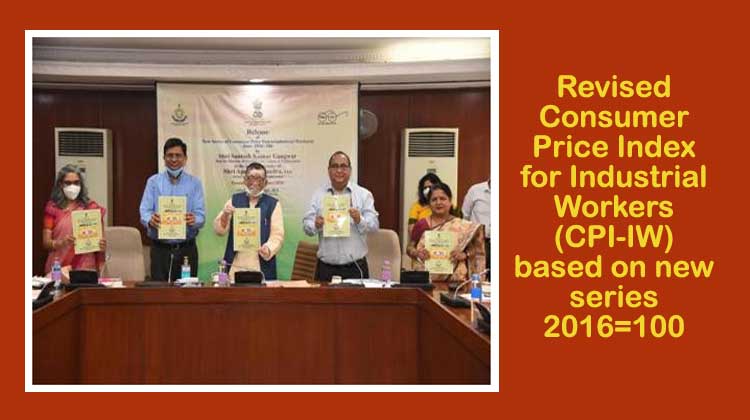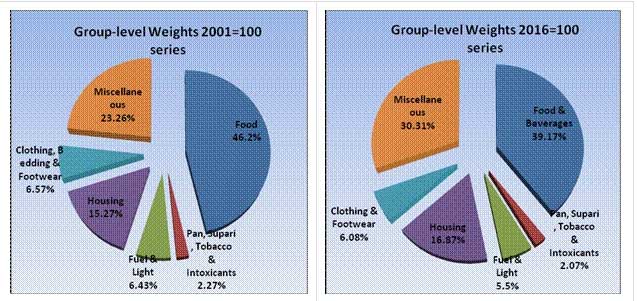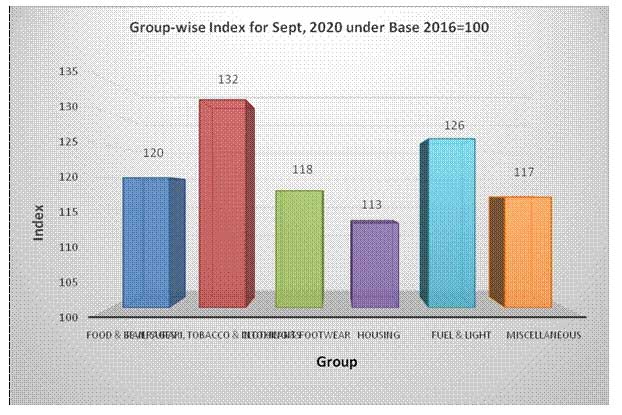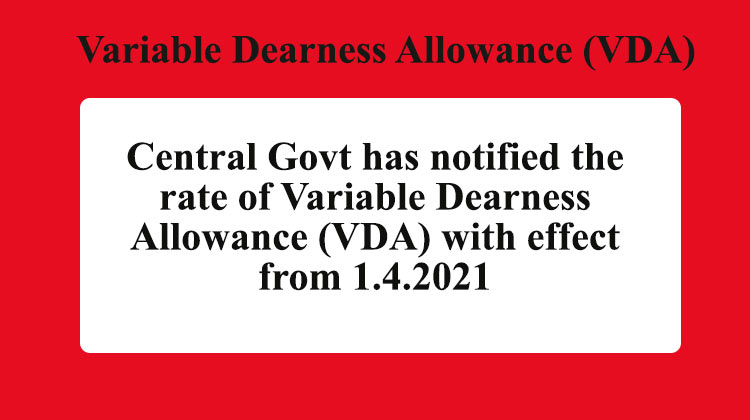
The CPI-IW (2016=100) series replaces the CPI-IW (2001=100) series. The new series is more representative in character and reflects the latest consumption pattern of the industrial workers
Sh. Santosh Gangwar released revised Consumer Price Index for Industrial Workers (CPI-IW) based on new series 2016=100 from the existing 2001=100
CPI-IW with new base represents latest consumption pattern of target population and will prove to be in the interest of workers : Labour Minister
Minister of State (I/C) for Labour& Employment Shri Santosh Kumar Gangwar, in the presence of ShriApurva Chandra, Secretary L&E and Shri DPS Negi, Senior Labour& Employment Advisor and Director General, Labour Bureau released the new series of Consumer Price Index for Industrial Worker (CPI-IW) with base year 2016, beingcompiled and maintained by Labour Bureau, an attached office of Ministry of Labour& Employment. The new series of CPI(IW) with base 2016=100 will replace theexisting series with base2001=100.
Earlier to this revision, the series were also revised from the year 1944 to 1949;1949 to 1960; 1960 to 1982 and 1982 to 2001 since inception of Labour Bureau.
In this regard, Union Labour Ministersaid that the revision of CPI-IW with new base covering representing latest consumption pattern of the target population will prove to be in the interest of workers in times to come.
Shri Gangwar said this will help in measurements of macroeconomic indicators of the Indian economy. He added the improvements made in it, incorporating international standards and practices, will make it more comparable at international level.
Minister lauded the efforts of Labour Bureau for their steadfastness and exemplary role which have finally culminated in the release of updated series of CPI(IW). While lauding the efforts, Minister mentioned that data on all aspects of labour is crucial to serve as inputs in policy making and this justifies the existence of an organization like Labour Bureau, dedicated to labourand price statistics. With the ever increasing importance of data in the times to come coupled with the fact that India is a labour abundant nation, a dedicated organization for labourand price statistics like the LabourBureau merits strengthening.
Shri Gangwar told media persons that the LabourBureau is making impressive strides on all the fronts. It has a rich legacy of producing quality labour statistics, the roots of which can be traced to its establishment in 1920. From the launch of a much needed logo after 100 years of its existence to moving to a new building and now Labour Bureau has releasednew series of CPI(IW).
Shri Apurva Chandra disclosed that Labour Bureau has initiatedthree big surveys on Employment generated by Professionals and non-formal transport sector, Migrant workers and Domestic workers. Labour Bureau has also been mandated with the task of collection of data on recently proposed four labour codes, he said. The Secretary assured to give all possible support to Labour Bureau in its future endeavours.
The Report on “New Series of Consumer Price Index for Industrial Workers (Base 2016=100)” is an important publication meant to give insights into the concepts, definitions and methodology related to the new series of CPI-IW with 2016 as base year. This will serve as a useful reference book for researchers, academicians, scholars and all other stakeholders of CPI-IW. As per the recommendations of International LabourOrganisation (ILO), Index Review Committee (IRC) and National Statistical Commission (NSC), the base year of price index numbers should be revised at frequent intervals generally not exceeding 10 years to reflect the changes that take place in the consumption pattern of consumers. The CPI-IW is compiled as per international best practices & guidelines of ILO.
Shri Gangwar also released the maiden index with base year 2016 for the month of September, 2020. The Index is compiled for 88 centres and All India. The All India index for the month of September, 2020 stands at the level of 118 and linking factor for the conversion of new series index to previous series on base 2001=100 is 2.88.
The CPI-IW (2016=100) series replaces the CPI-IW (2001=100) series. The new series is more representative in character and reflects the latest consumption pattern of the industrial workers.
Shri Gangwar elaborated some of the important improvements made under the new series of CPI-IW (2016=100) vis-à-vis old series (2001=100)which are as under:
A total of 88 centers have been covered in the 2016 series as against 78 centers in the 2001 series.
The sample size for the conduct of Working Class Family Income and Expenditure Survey, on the basis of which weighting diagrams have been derived, was increased to 48384 families from 41040 in the 2001 series.
The number of selected markets for collection of retail price data has also been increased to 317 markets under the 2016 series as against 289 markets covered in the 2001 series.
The number of items directly retained in the index basket has increased to 463 items as against 392 items in the 2001 series.
The number of States/UTs has increased to 28 under 2016 series as against 25 in the 2001 series.
In the new series, as per the direction of Technical Advisory Committee (TAC) on Statistics of Prices and Cost of Living (SPCL), the Geometric mean based methodology (GM of Price Relatives) is used for compilation of indices as against Arithmetic mean used in 2001 series.
The group level weights under new series has changed in comparison to earlier series (1982 and 2001). The weight of Food & Beverages has declined over time whereas the weight of Miscellaneous group(Health; Education & Recreation; Transport & Communication; Personal Care & Effects; Household Goods & Services etc.) has increased substantially under 2016 series vis-à-vis earlier series. The weight of Housing Group has reported an increasing share over period of time.


The Group-wise Index for the month of September, 2020 varies from 113 points of Housing group to 132 points of Pan, Supari, Tobacco & Intoxicants group under new series.

Shri D.P.S.Negi, Director General, Labour Bureau said that the linking factor of new series 2016=100 to old series of CPI-IW (2001=100) is 2.88. There are 65 common centres between both the series and the linking factor of common centers ranges from 2.38 of Doom-Dooma Tinsukia to 3.60 of Nagpur.
Shri Negi said the All-India Consumer price Index Numbers for Industrial Workers (CPI-IW) for the month of September, 2020 is released on New Base: 2016=100. The maiden index on new base for September, 2020 stands at the level of 118 and linking factor for the conversion of new series index to previous series on base 2001=100 is 2.88.
In the new series is broader in scope and larger in perspective. The coverage widened to 88 centres against 78 centres in the previous series. Rise in number of markets from 317 collecting retail consumer prices of 463 items against 289 markets and 392 items in the old series makes it more representative in character and reflects the latest consumption pattern of the target population, i.e., industrial workers.
Unlike predecessors, the new series has same survey base year and price base which in itself is a major improvement. It is also released in the shortest time span of less than 4 years as never before.
The Technical Advisory Committee on Statistics of Prices and Cost of Living (TAC and SPCL) has approved the new series.
The CPI-IW is the single most important price statistics, which has financial implications. It is primarily used to regulate the dearness allowance of government employees and the workers in the industrial sectors. It is also used in fixation and revision of minimum wages in scheduled employments besides measuring the inflation in retail prices.
The next issue of CPI-IW for the month of October, 2020 will be released on Friday 27th November, 2020. The same will also be available on the office website www.labourbureaunew.gov.in.




